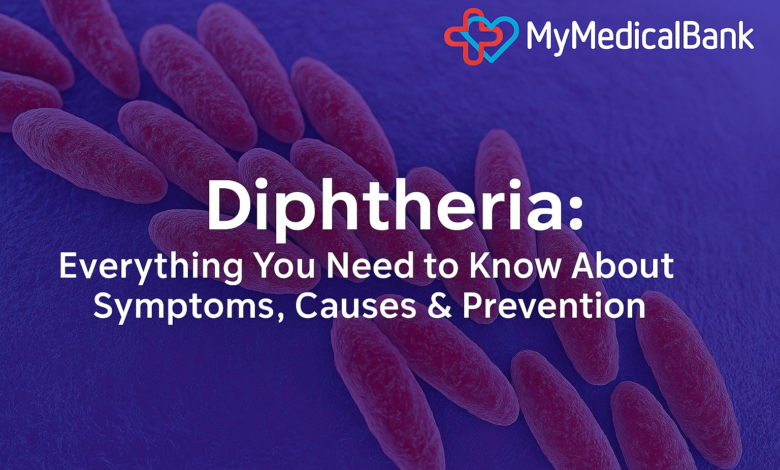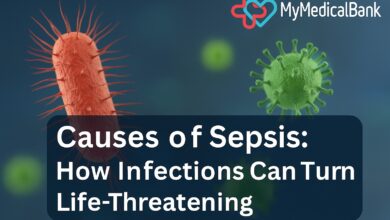Diphtheria : Everything You Need to Know About Symptoms, Causes & Prevention

Diphtheria may sound like a disease from history books, but it remains a real and dangerous threat in some parts of the world. It’s a highly contagious bacterial infection that targets the nose, throat, and windpipe (trachea), making it difficult to breathe. The culprit is a bacterium called Corynebacterium diphtheriae, which releases powerful toxins. These toxins trigger the formation of a thick, grayish membrane in the throat, which can block the airway and potentially lead to suffocation.
Awareness of diphtheria is crucial because the bacteria that cause it can survive on surfaces and objects for long periods, making it easier for the disease to spread. Without knowing this, people might overlook the importance of regular cleaning and disinfection. High-risk locations, such as schools, daycare centers, and healthcare facilities, are particularly vulnerable. By understanding the role of sanitation in preventing diphtheria, communities can take proactive steps like cleaning frequently touched surfaces to reduce bacterial growth and stop transmission before it happens.
Corynebacterium diphtheriae spreads mainly through respiratory droplets, tiny particles released when an infected person coughs, sneezes, or even talks. These droplets can be inhaled directly or picked up from contaminated surfaces if someone touches their nose or mouth afterward.
Close contact increases the risk, which is why outbreaks often happen in crowded or poorly ventilated areas. The bacteria can also be transmitted through direct contact with open sores or wounds caused by the infection. In rare cases, sharing personal items like utensils, towels, or bedding with an infected person can pass the bacteria along.
Once inside the body, Corynebacterium diphtheriae produces toxins that attack the lining of the throat and nose, setting the stage for the disease’s most dangerous symptoms.
The infection spreads in two main ways:
1. Airborne Droplets
When an infected person coughs or sneezes, they release tiny droplets containing the bacteria into the air. If someone nearby breathes in these droplets, they can become infected. This makes diphtheria especially easy to spread in crowded environments such as classrooms, public transport, or community gatherings.
2. Direct Contact
The bacteria can also spread through direct contact with an infected person or with objects they have used, such as towels, tissues, or eating utensils. Caregivers and family members are at higher risk because they often handle personal items or have close physical contact with the patient. In some cases, touching skin ulcers caused by diphtheria can also transmit the bacteria.
Symptoms of Diphtheria
Diphtheria mostly attacks the respiratory system, which includes the nose, throat, and windpipe all the parts responsible for breathing. Once Corynebacterium diphtheriae attaches to the lining of these areas, it starts releasing toxins that trigger the first wave of symptoms, such as:
- Mild fever
- General weakness or fatigue
- Sore throat
- Swollen glands in the neck
Typically, more serious symptoms appear 2–5 days after infection. These can include:
- Persistent nasal discharge
- Hoarseness or a worsening sore throat
- Rapid, labored, or noisy breathing
- Noticeably enlarged lymph nodes in the neck
- Formation of a thick, grayish membrane over the throat and tonsils, which can make swallowing and breathing difficult
Home Remedies and Care Tips for Diphtheria
Recovering from diphtheria isn’t just about taking medication; it also involves making key lifestyle adjustments to support healing.
First, plenty of bed rest is essential. The body needs time and energy to fight the infection, and physical activity, especially when the heart has been affected, should be avoided. If swallowing is painful or difficult, switch to a soft or liquid diet, such as warm soups, to make eating easier.
It’s also important to practice strict isolation during recovery. This helps prevent the infection from spreading to others and reduces the risk of an outbreak. Family members should be extra careful about hygiene; washing hands thoroughly with soap and running water is a simple but powerful step in stopping the spread.
Once recovery is complete, getting a full course of the diphtheria vaccine is strongly advised. Unlike some illnesses, having diphtheria once doesn’t guarantee lifetime immunity. Without full vaccination, a person can get infected again.
Preventing Diphtheria: Why Immunization Matters
The most effective way to protect yourself from diphtheria is through vaccination. The diphtheria vaccine contains a weakened form of the bacterial toxin, known as a toxoid. While it can’t cause the disease, it triggers the body to produce an “antitoxin,” a specific antibody that neutralizes the harmful diphtheria toxin. For strong and lasting protection, several doses are required over time.
Different vaccine combinations are used depending on a person’s age. Children can access the diphtheria vaccine for free as part of the national immunization schedule:
- At 2, 4, and 6 months: Given as a combined vaccine that also protects against tetanus, whooping cough, hepatitis B, polio, and Haemophilus influenzae type b (Hib).
- At 18 months: A booster dose in the form of a diphtheria, tetanus, and whooping cough vaccine.
- At 4 years : Another booster combining diphtheria, tetanus, whooping cough, and polio protection.
- During adolescence:A final booster against diphtheria, tetanus, and whooping cough, typically administered at school, by a doctor, or at a local council immunization session.
By following the full vaccination schedule, you significantly reduce your risk of contracting diphtheria and help prevent its spread in the community.
In Nigeria, diphtheria vaccination is included in the national immunization schedule and is available free of charge at government health facilities nationwide. Parents and caregivers can take their children to primary health centres, general hospitals, or other public health clinics to receive the vaccine at no cost.
Conclusion
Diphtheria may no longer dominate global headlines, but it is far from eradicated. Its ability to spread quickly, cause life-threatening complications, and re-infect those without full vaccination makes it a serious public health concern. The good news is that prevention is within reach through consistent immunization, proper hygiene practices, and prompt treatment when cases arise.
Communities, schools, and families all play a role in stopping the spread. Regular cleaning of shared spaces, awareness of symptoms, and ensuring vaccination schedules are up to date can save lives. In countries like Nigeria, where free vaccination is available at government health facilities, taking advantage of this service is one of the simplest yet most effective steps toward protecting yourself and those around you.
By staying informed and proactive, you can subscribe to our newsletter Here



